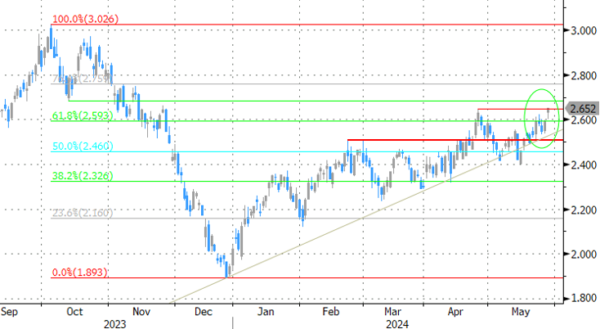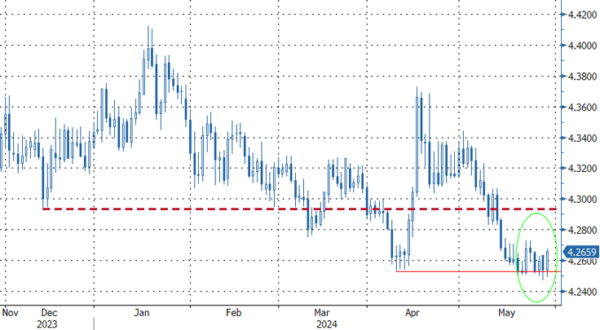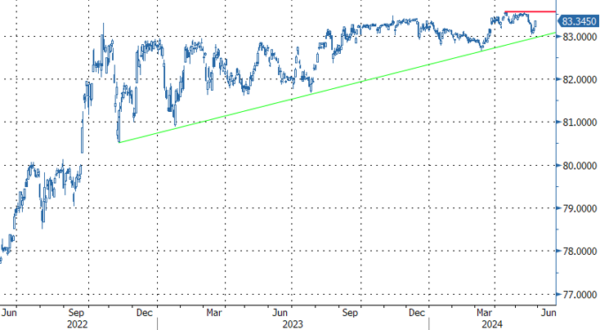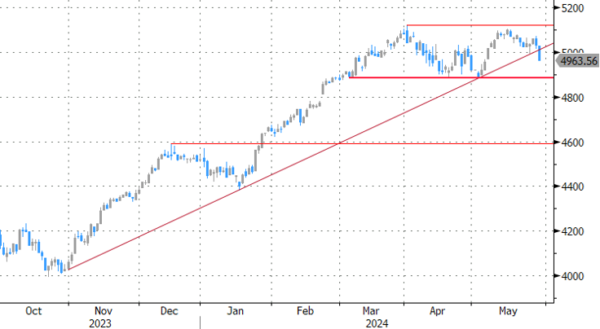Markets
German bunds underperformed US Treasuries today. We should speak in the conditional tense though because there’s still the $44 bn 7-yr auction scheduled after the European close. A mediocre 2-yr and 5-yr sale yesterday triggered additional losses for Treasuries and was the reason for European/German yields to catch up straight at the open. German rates then dipped again on the release of regional inflation numbers. The m/m readings in most cases varied between flat and +0.1%, showing a clear easing of price momentum in May. The yearly print (HICP), published a few hours later, reaccelerated nonetheless due to unfavorable base effects. The 2.8%, up from 2.4%, was even slightly higher than expected (2.7%). As the session evolved, yields found a bottom and eventually fully erased the inflation-induced dip. Perhaps this tells something about the underlying trend. Data of this kind could have easily propelled ECB easing bets from currently two to three rate cuts this year, but it barely did. The ECB release of credit developments (April) may have helped the process as well, showing that the drag on spending from credit provision continues to ease. It at the very least suggests there is no need for the ECB to cut rates aggressively to avert some kind of a credit crunch. German rates currently add between 3.5 (2-yr) and 7.3 bps (30-yr) bps. The 10-yr yield (+7.2 bps) moved towards a new YtD high. US rates rise up to 5.5 bps at the long end of the curve.
The climb in yields weighs on equity markets (EuroStoxx50 -1.4%, WS opens between 0.8 and 0.95% lower), outweighing the effect of narrowing interest rate differentials for the US dollar. EUR/USD loses a few ticks to change hands in the 1.083 area, though it does trade above the intraday lows. DXY ekes out a tiny gain to 104.82 in technically irrelevant trading. EUR/GBP dropped below 0.85-support in a kneejerk reaction to the German (regional) inflation numbers to hit the lowest level since September 2022. But the subsequent recovery in European yields prevents a bearish break for now. The combo is filling bids around 0.851.
News & Views
Polish CPI inflation slowed to 0.1% M/M from 1.1% in April. Low base effects from last year raised to Y/Y measure to from 2.4% to 2.5%, exactly matching the target of the National Bank of Poland (NBP), but well below the consensus estimate of 2.8%. Prices for electricity, gas and other fuels declined 0.3% M/M and were up 1.8% Y/Y. Food price inflation slowed to 0.3% M/M and 1.6% Y/Y (from 1.9%). On the basis of today’s data, KBC economics estimates core inflation to have slowed to 3.5% Y/Y (was 4.1% in April). Softer than expected inflation will fuel the debate whether the NBP should consider cutting its policy rate later this year. Recently, the majority of Polish MPC members including governor Glapinski indicated to see little/no room to cut interest rates this year. They refer to a high degree of uncertainty with respect to the path of inflation in H2 due to fiscal and regulatory policies. A marked wage growth also might stimulate demand growth in the economy. In a context of higher EMU yields, Polish 2-y and 10-y swap yields declined 7 bps (4.49%) and 8 bps (5.31%) respectively. The zloty eased slightly to EUR/PLN 4.2575, but is holding near the strongest level against the euro since early 2020, touched yesterday.
S&P global ratings today raised the outlook on India’s sovereign credit rate to positive from stable. The rating remains at BBB-. The country’s robust expansion is having a constructive impact on its credit metrics and sound economic fundaments is seen underpinning growth over the next two to three years. S&P also expects broad continuity in economic reforms and fiscal policy regardless of the outcome of the election. Government spending being transformed with an increasing share going to infrastructure is expected to ease bottlenecks to put the country on a higher growth trajectory. The agency also sees a political commitment to fiscal consolidation. Even as fiscal settings always have been the most vulnerable part of this rating profile, S&P projections see the country’s general government deficit at 7.9% of GDP in fiscal 2025 to decline to 6.8% in 2028. After rebounding from near record low levels last week, the Indian rupee this week came again under pressure due to broader dollar strength weighing on regional currencies. USD/INR today rises to 83.35 with the all-time low of the rupee near 83.57 reached mid-April.
Graphs
German 10-yr yield rises to new YtD high despite slowing (m/m) inflation
EUR/PLN: zloty eases slightly as softer CPI pressures hawkish NBP
USD/INR: Indian rupee not impressed with S&P’s outlook upgrade
EuroStoxx 50: climb in (real) yields this time around doesn’t go unnoticed on equity markets

















